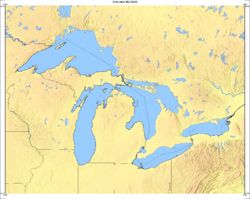Great Lakes
 From Conservapedia - Reading time: 2 min
From Conservapedia - Reading time: 2 min
The Great Lakes are a series of five lakes located between the United States and Canada in north central North America. Together they are the largest group of fresh water lakes on Earth, making up 18% of total world supply.
The Great Lakes are all Indian names, except for "Superior" which is from the French for upper:[1]
- Lake Superior
- Lake Michigan - The only Great Lake located entirely in the United States.
- Lake Huron
- Lake Ontario
- Lake Erie
The Great Lakes are a Counterexample to an Old Earth, because they are a statistical anomaly that could not have existed more than 5,000 or 10,000 years without drying up. To get around this problem, atheistic scientists imagine a relatively recent "Ice Age" that magically carved the Great Lakes and filled them with fresh water upon the melting of the ice. An obvious defect to this theory is the shape of the Great Lakes, which does not suggest any trajectory from north to south.
| Lake | Area (sq. miles) |
Volume (cubic miles) |
Maximum depth (feet) |
Height above sea level (feet) |
Shoreline (miles) |
Outlet |
|---|---|---|---|---|---|---|
| Superior | 31,700 | 2900 | 1332 | 600 | 2726 | St. Marys River |
| Michigan | 22,300 | 1180 | 925 | 577 | 1638 | Straits of Mackinac |
| Huron | 23,000 | 850 | 750 | 577 | 3827 | Straits of Mackinac |
| Erie | 9,910 | 116 | 210 | 569 | 871 | Niagara River |
| Ontario | 7,340 | 393 | 802 | 243 | 712 | St. Lawrence River |
Several other large lakes and islands make up part of the Great Lakes System. They drain through the Saint Lawrence River into the Gulf of Saint Lawrence. In 1959 the Saint Lawrence Seaway opened the Great Lakes to ocean-going boats, allowing travel well into the heart of North America. Although the Great Lakes themselves had been connected before this by a series of canals.
Since 1909 the United States and Canada have cooperated on the management and control of lake water with the International Joint Commission (IJC). At Niagara Falls, as much as 60% of the water is diverted for hydroelectric power generation for Ontario and New York State.
Because of the large size of the lakes many of the larger cities (notably Buffalo, New York) experience lake effect snow, where westerly winds capture moisture over the unfrozen lakes and when cooled over the land, heavy snows can fall. Additionally the lakes can moderate the warm temperatures in the summer, and release the heat in the fall.
Water Levels[edit]
| “ | Water levels in the Great Lakes have fluctuated since 1860. Over the last few decades, water levels have declined slightly for most of the Great Lakes (see Figure 1). The past few years, however, have shown notable increases toward the top of the historical range. | ” |
In 2022, the water levels in the Great Lakes are 1-3 feet above average, which helps combat drought and also facilitates cargo shipping with heavier loads and bigger boats.
 KSF
KSF